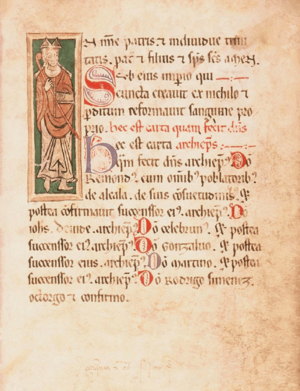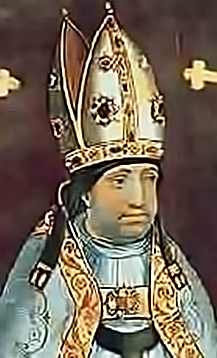Rodrigo Jiménez de Rada facts for kids

Rodrigo Jiménez (also known as Ximénez) de Rada was a very important church leader and historian. He was born around 1170 and passed away on June 10, 1247. He played a big role in the Kingdom of Castile during the reigns of King Alfonso VIII and King Ferdinand III. This was a time when Castile became the strongest kingdom in the Iberian Peninsula (where Spain and Portugal are today). He was the head of the Archdiocese of Toledo (a major church area) from 1208 to 1247. He also wrote a famous history book called De rebus Hispaniae, which tells the story of the Iberian Peninsula.
Contents
The Early Life of Rodrigo Jiménez
Rodrigo Jiménez de Rada was born around 1170 in Puente la Reina, a town in the Kingdom of Navarre. He came from a noble family in Navarre. His uncle, Martín de la Finojosa, helped educate him. His uncle was an abbot (head of a monastery) and a bishop of Sigüenza (a church leader for a specific area). Rodrigo studied Law and Theology (the study of religion) at famous universities in Bologna, Italy, and Paris, France.
Rodrigo's Rise to Power
When Rodrigo returned to Navarre, he helped settle disagreements between Navarre and Castile. He became good friends with King Alfonso VIII of Castile. The King then named him bishop of Osma. Later, King Alfonso VIII encouraged the church leaders in Toledo to choose Rodrigo as the archbishop of Toledo. This was a very important position. Pope Innocent III officially approved his election on February 12, 1209. King Alfonso VIII also made him the main chancellor (a high-ranking official) of Castile.
A Leader in War and Peace
Rodrigo played a key role in the war against the Almohads, who were Muslim rulers in the south of Spain. He was especially important at the battle of Las Navas de Tolosa in 1212. This battle was seen across Europe as a crusade (a holy war), and many knights from different European countries joined in. Rodrigo was the moral leader of this effort. After the victory, he sent missionaries to Morocco. His archbishopric (the area he governed as archbishop) gained a lot of land in the Guadalquivir valley, especially around Quesada. He also received many gifts of land from kings and lords.
Building and Culture in Toledo
As archbishop of Toledo, Rodrigo started the building of the grand cathedral. He laid the first stone in 1226. The cathedral was not finished until 1493! He also helped bring back the church areas of Baeza and Córdoba after Christian forces took control of those cities. He strongly defended Toledo's position as the most important church center in Spain.
Rodrigo also encouraged cultural life in Toledo. At that time, Toledo was a special place where Christian and Muslim cultures mixed and shared ideas. He ordered the Koran (the holy book of Islam) to be translated into Latin. He also wrote many historical works. His book, De rebus Hispaniae, which was a general history of Spain, was quickly translated into Spanish. It greatly influenced the General History written by King Alfonso X.
Rodrigo Jiménez de Rada died near Lyons, France, while returning from a visit to Pope Innocent IV. He is buried in the monastery of Saint Mary of Huerta.
Writings
- De rebus Hispaniae
- Hunnorum, Vandalorum et Silingorum Historia
- Ostrogothorum Historia
- Historia Romanorum
- Historia Arabum
See also
 In Spanish: Rodrigo Jiménez de Rada para niños
In Spanish: Rodrigo Jiménez de Rada para niños


